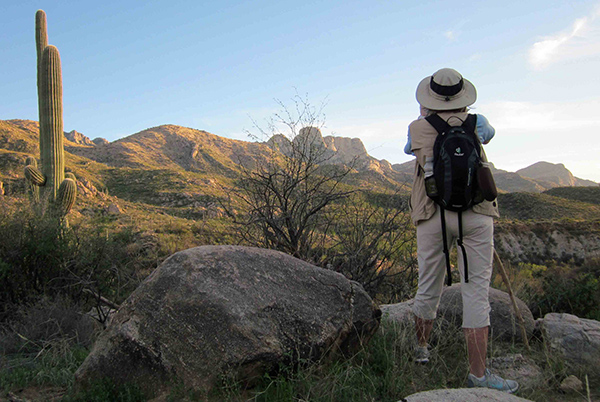Fungal Disease Personal Stories: Laura’s Story

Laura exploring the desert near her home in Arizona.
In June 2020, Laura started having a fever, chills, rash, and constant tiredness. Her symptoms worsened over the following weeks. She developed muscle aches, a headache, night sweats, an increased pulse rate, and a dry cough that wouldn’t go away. Soon after, she started having trouble breathing. She thought it might be COVID-19, but her test came back negative.
Laura’s doctor ordered other tests, which showed she had pneumonia. She was prescribed antibiotics, but her symptoms still didn’t improve. After another negative COVID-19 test, she asked her doctor to test for a fungal disease called Valley fever (coccidioidomycosis). The test came back negative. Laura expressed her frustrations to her friends and family, who also suspected she had Valley fever.
A month later, Laura went to see a pulmonologist (a lung specialist).
“I wanted to know what was making me so sick. After feeling this way for such a long time, I knew something was wrong,” said Laura. “Being a person with diabetes, I take my health very seriously since my immune system is compromised.” A scan showed large masses in her lungs, which her doctor monitored for a few weeks, but her symptoms persisted.
Finally, a second test revealed that Laura did have Valley fever. Her road to recovery could now begin. Like many people who get Valley fever, Laura had symptoms for a long time before she got an accurate diagnosis. Sometimes, a person’s first blood test for Valley fever can be negative, even if they really do have the infection.

Laura travelling in 2016.
Laura lives in Arizona, where Valley fever is common. The fungus that causes this infection also lives in other parts of the western United States and Central and South America. People can get Valley fever by breathing in the microscopic fungal spores from the air.
“I knew a little about Valley fever before I got it,” she said. “Even though many people get sick from it here, people really don’t talk about it or really understand what it is.”
For many people, the symptoms of Valley fever go away without treatment, but some people need antifungal medication. Laura took antifungal medication for a month and experienced strong side effects from it. Before she got sick, Laura was very active and enjoyed exercising.
“I’m usually very active; I like to take long bike rides and walks with my dog. I had to give up playing golf for the summer and fall. At first, I tried to stay active, but once the fatigue, joint and muscle pain kicked in, it made it impossible to do the things I loved,” said Laura.
Today, she continues to recover and hopes her story will help others like her by increasing awareness of fungal diseases like Valley fever. “Being able to speak to others about my experience with Valley fever has changed my life…telling people the possibilities are really important,” she said.
If you think you might have Valley fever, talk with a healthcare provider.
Symptoms of Valley fever and some other fungal diseases can be similar to those of COVID-19, including fever, cough, and shortness of breath. Laboratory testing is necessary to determine if a person has a fungal infection or COVID-19, and doctors should consider fungal infections in people who are experiencing these symptoms and aren’t getting better, particularly if COVID-19 testing is negative.